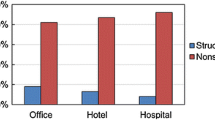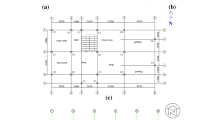Abstract
A seismic performance comparison is made for warehouse buildings constructed using (a) rocking precast hollow core wall with (b) fixed-base monolithic conventional walls. Incremental dynamic analysis (IDA) is used as a basis for a comparative performance-based earthquake engineering assessment. The initial step is to model each wall type using nonlinear dynamic analysis subjected to 20 selected earthquakes records. Wall performance is analysed from low to high ground motions until collapse. Responses in terms of wall displacements (drifts) are examined statistically and IDA curves are parameterized into various percentile bands. Once damage limit states are assigned and coupled with hazard-recurrence risk relations the results are integrated to indicate probable losses. This vulnerability assessment reveals that precast hollow core walls using damage avoidance design philosophy perform considerably better than fixed-based conventional wall panels designed for ductile performance.

Similar content being viewed by others
References
Vamvatsikos D., Cornell C.A.: Direct estimation of seismic demand and capacity of multidegree-of-freedom system through incremental dynamic analysis of single degree of freedom approximation. J. Struct. Eng. ASCE 131(4), 122–134 (2005)
Cornell, C.A., Luco, N.: The effects of connection fractures on steel moment resisting frame seismic demands and safety: a report on SAC Phase II Task 5.,4.6. Rep. No. SAC-BD/99-03. SAC Joint Venture, Sacramento, California (1999)
Cornell C.A., Jalayer F., Hamburger R.O., Foutch D.A.: Probabilistic Basis for 2000 SAC Federal Emergency Management Agency Steel Moment Frame Guidelines. J. Struct. Eng. ASCE 128(4), 526–531 (2002)
Luco N., Cornell C.A.: Effects of connection fractures on SMRF seismic drift demands. J. Struct. Eng. ASCE 126(1), 127–136 (2002)
Lee K., Foutch D.A.: Performance evaluation of new steel frame buildings for seismic loads. Earthq. Eng. Struct. Dyn. 31(4), 653–670 (2002)
Vamvatsikos D., Cornell C.A.: Applied incremental dynamic analysis. Earthq. Spectra 20(2), 324–335 (2004)
Vamvatsikos D., Cornell C.A.: Incremental dynamic analysis. Earthq. Eng. Struct. Dyn. 31, 491–514 (2002)
Shome, N., Cornell, C.A.: Probabilistic Seismic Demand Analysis of nonlinear structures, Report No. 5, RMS-35, RMS Program, Stanford University, Stanford (1999). http://pitch.stanford.edu/rmsweb/Thesis/NileshShome.pdf
NZS 1170.5. New Zealand Standard Code of Practice for Structural Design Actions, Part 5: Earthquake Actions, New Zealand. Wellington, New Zealand (2004)
Ramberg, W., Osgood, W.R.: Description of stress-strain curves by three parameters. Technical Note 902, National Advisory Committee for Aeronautics (1943)
Giovenale P., Cornell C.A., Esteva L.: Comparing the adequacy of alternative ground motion intensity measures for the estimation of structural responses. Earthq. Eng. Struct. Dyn. 33(5), 951–979 (2004)
Mander, J.B., Cheng, C.-T.: Seismic Resistance of Bridge Piers Based on Damage Avoidance Design. Technical Report NCEER-97-0014. Department of Civil, Structural and Environmental Engineering, State University of New York at Buffalo, New York (1997)
Holden T.J., Restrepo J., Mander J.B.: Seismic Performance of precast reinforced and prestressed concrete walls. J. Struct. Eng. ASCE 129(3), 286–296 (2003)
Kennedy R.P., Cornell C.A., Campbell R.D., Kaplan S., Perla H.F.L.: Probabilistic seismic safety study of an existing nuclear power plant. Nucl. Eng. Des. 59, 315–338 (1980)
Hamid, N.H.: Seismic damage avoidance design of warehouse buildings constructed using precast hollow core panels. PhD thesis. Department of Civil Engineering, University of Canterbury, Christchurch, New Zealand (2006)
NZS 3101: Part 1: New Zealand Standard Code of Practice for Concrete Structures Standard: The Design of Concrete Structures. Wellington, New Zealand (1995)
Carr, A.J.: RUAUMOKO: Inelastic Dynamic Analysis Program. Department of Civil Engineering. University of Canterbury, Christchurch, New Zealand (2003)
Author information
Authors and Affiliations
Corresponding author
Rights and permissions
About this article
Cite this article
Hamid, N.H., Mander, J.B. A Comparative Seismic Performance Between Precast Hollow Core Walls and Conventional Walls Using Incremental Dynamic Analysis. Arab J Sci Eng 37, 1801–1815 (2012). https://doi.org/10.1007/s13369-012-0301-7
Received:
Accepted:
Published:
Issue Date:
DOI: https://doi.org/10.1007/s13369-012-0301-7




